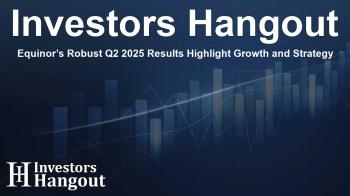Equinor’s Robust Q2 2025 Results Highlight Growth and Strategy

Equinor Reports Impressive Financial Results for Second Quarter
Equinor (OSE: EQNR, NYSE: EQNR) has released its financial outcomes for the second quarter of 2025, showcasing an adjusted operating income* of USD 6.53 billion. The company also reported an after-tax income of USD 1.74 billion. Moreover, the net operating income stands at USD 5.72 billion, while the net income is marked at USD 1.32 billion. The adjusted net income was recorded at USD 1.67 billion, translating into an adjusted earnings per share* of USD 0.64.
Financial Highlights and Operational Performance
Equinor's solid financial results reflect strong operational capabilities and growth in production, particularly in the US onshore gas sector.
- Strong operational performance coupled with a notable increase in production.
- Increased US onshore gas production led to better pricing outcomes.
- Expenditures remain stable and align with forecasted capital expenditures.
- The company's balance sheet continues to exhibit strength amidst fluctuating price environments.
Strategic Developments and Progress
Alongside financial accomplishments, Equinor has achieved significant strides in its strategic initiatives:
- Milestones were reached in key projects, including Johan Castberg and Johan Sverdrup phase 3.
- The company has announced the divestment of the Peregrino field in Brazil for USD 3.5 billion.
- Successful financial closure for the Baltyk 2 & 3 offshore wind projects in Poland was attained.
- Empire Wind 1 project development is back underway, although regulatory changes have led to impairments affecting future projects.
Insight from Leadership
Anders Opedal, President and CEO of Equinor ISA, shared insights: “We are enthusiastically on track for production growth in 2025, contributing to our long-term commitment to being a reliable energy supplier to Europe. Our strategic investment in US onshore gas last year yields impressive value, demonstrated by dramatic increases in production and pricing.”
Production and Energy Generation Metrics
In the second quarter, Equinor achieved a total equity production of 2,096 mboe per day, reflecting a 2% growth from 2,048 mboe during the same quarter last year. Strong operational performance on the Norwegian continental shelf was a key factor.
The Johan Castberg field has reached its production plateau, further countering natural declines and planned maintenance-induced decrease at processing plants. Additionally, the US markets have bolstered Equinor's production capacity, contributing to a remarkable 28% year-over-year increase in oil and gas output.
In renewable energy, total power generation from the renewable portfolio reached 0.83 TWh, primarily driven by increased production from Dogger Bank A and the newly acquired Lyngsåsa wind farm in Sweden.
A Comprehensive Financial Overview
The adjusted operating income of USD 6.53 billion reflects variations influenced by the downward trend of liquids prices, which was counterbalanced by higher gas prices.
Equinor's reported net operating income decreased from USD 7.66 billion in the previous year, impacted notably by impairments tied to regulatory adjustments concerning offshore wind projects, with a hit of USD 955 million.
Cash flow generation was robust, presenting cash flows from operations of USD 9.17 billion before tax liabilities. The company also paid significant tax installments related to the NCS, amounting to USD 6.85 billion during the quarter.
Capital Expenditures and Financial Metrics
The company’s organic capital expenditures totaled USD 3.40 billion, while the total capital expenditures reached USD 3.58 billion. The net debt to capital employed ratio adjusted to 15.2% by the end of the quarter, indicating a shift from 6.9% previously.
Future Outlook and Continued Commitment
Equinor's ongoing projects signal its proactive approach in ensuring long-term production viability and value. Notable advancements include reaching the financial commitment for Baltyk offshore wind projects and positive developments in prospective gas sales agreements. The company aims for a competitive cash dividend and plans to implement a share buy-back program, highlighting its dedication to enhancing shareholder value.
Frequently Asked Questions
What were Equinor's total revenues in the second quarter of 2025?
Equinor reported an adjusted operating income of USD 6.53 billion in the second quarter of 2025.
What key projects did Equinor achieve milestones in during this quarter?
Key projects included advances on Johan Castberg, Johan Sverdrup phase 3, and Baltyk offshore wind projects.
How has Equinor's production improved compared to last year?
The company recorded a 2% increase in total equity production from 2,048 mboe to 2,096 mboe.
What is the expected total capital distribution for 2025?
Equinor expects a total capital distribution of USD 9 billion for the year 2025.
Who can be contacted for more information about Equinor's financial results?
For investor relations, Bård Glad Pedersen is reachable at +47 918 01 791.
About The Author
Contact Thomas Cooper privately here. Or send an email with ATTN: Thomas Cooper as the subject to contact@investorshangout.com.
About Investors Hangout
Investors Hangout is a leading online stock forum for financial discussion and learning, offering a wide range of free tools and resources. It draws in traders of all levels, who exchange market knowledge, investigate trading tactics, and keep an eye on industry developments in real time. Featuring financial articles, stock message boards, quotes, charts, company profiles, and live news updates. Through cooperative learning and a wealth of informational resources, it helps users from novices creating their first portfolios to experts honing their techniques. Join Investors Hangout today: https://investorshangout.com/
The content of this article is based on factual, publicly available information and does not represent legal, financial, or investment advice. Investors Hangout does not offer financial advice, and the author is not a licensed financial advisor. Consult a qualified advisor before making any financial or investment decisions based on this article. This article should not be considered advice to purchase, sell, or hold any securities or other investments. If any of the material provided here is inaccurate, please contact us for corrections.

